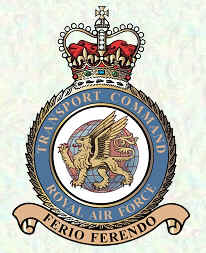RAF Transport Command
| Royal Air Force Transport Command | |
|---|---|

Command crest
|
|
| Active | 25 March 1943–1 August 1967 |
| Country |
|
| Branch |
|
| Type | Command |
| Role | controlling Transport aircraft |
| Motto(s) |
Latin: Ferio Ferendo ("I Strike by Carrying") |
| Engagements | Second World War |
| Insignia | |
| crest heraldry | A golden griffon in front of a globe |
RAF Transport Command was a Royal Air Force command that controlled all transport aircraft of the RAF. It was established on 25 March 1943 by the renaming of the RAF Ferry Command, and was subsequently renamed RAF Air Support Command in 1967.
During the Second World War, it at first ferried aircraft from factories to operational units and performed air transport. Later it took over the job of dropping paratroops from Army Cooperation Command as well.
After the Second World War, it increased rapidly in size. It took part in several big operations, including the Berlin Airlift in 1948, which reinforced the need for a big RAF transport fleet. The Handley Page Hastings, a four-engined transport, was introduced during the Berlin Airlift and continued as a mainstay transport aircraft of the RAF for the next 15 years. In 1956, new aircraft designs became available, including the de Havilland Comet (the first operational jet transport), and the Blackburn Beverley. In 1959, the Bristol Britannia was introduced.
During the 1960s the command was divided into three different forces:
The principal RAF Transport Command functions of this period were support operations involving the evacuation of military personnel from the Suez Canal Zone prior and after the Suez Crisis of October–November 1956; casualty evacuation from South Korea during the Korean War and from the Malaya during the Malayan Emergency; essential supplies to Woomera, South Australia, and ferrying personnel and supplies out to Christmas Island for the atomic bomb tests carried out by the UK. In addition, Transport Command ran scheduled routes to military staging posts and bases in the Indian Ocean region, Southeast Asia and the Far East, to maintain contact between the UK and military bases of strategic importance. It also carried out special flights worldwide covering all the continents bar Antarctica. Many varied tasks were undertaken during the 1950s.
...
Wikipedia
